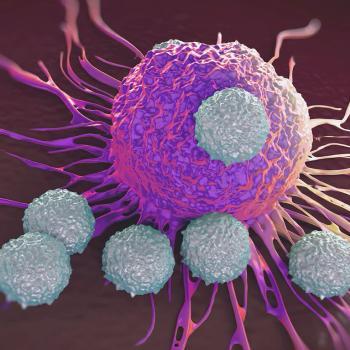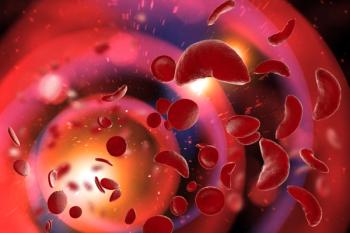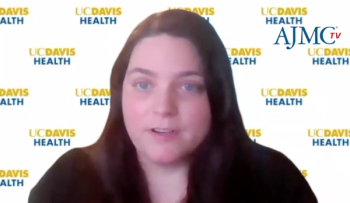
- January 2024
- Volume 30
- Issue 1
- Pages: SP69-SP71
Updated Data for Odronextamab Show Durable Responses in R/R DLBCL, 73% Complete Response in R/R Follicular Lymphoma
New data presented for odronextamab show the bispecific antibody produced strong responses in a pair of non-Hodgkin lymphoma subtypes that collectively account for more than 45,000 cancer diagnoses in the United States each year.1 The FDA is evaluating odronextamab in both diffuse large B-cell lymphoma (DLBCL), an aggressive disease in which patients may exhaust treatment options, and follicular lymphoma (FL), which progresses more slowly but still lacks a cure.2 Officials with Regeneron Pharmaceuticals, Inc, developer of odronextamab, say the investigational therapy is designed to “bridge CD20 on cancer cells with CD3-expressing T cells to facilitate local T-cell activation and cancer cell killing.”3
Results presented during the 65th American Society of Hematology (ASH) Annual Meeting and Exposition on December 10, 2023, in San Diego, California, offered a mix of updates for pivotal trial results presented a year prior in New Orleans, Louisiana, along with exploratory data on the association between measures of minimal residual disease (MRD) and progression-free survival (PFS).3-7 The data come ahead of FDA’s March 31, 2024, deadline to act on Regeneron’s application for approval of odronextamab in relapsed/refractory (R/R) DLBCL and R/R FL.3
New Data in DLBCL
Final results from the phase 2 ELM-2 study (NCT03888105) were presented in an oral session.4 After a median follow-up of 26.2 months, 141 patients with DLBCL were evaluable for safety and 127 were evaluable for efficacy. Results showed that odronextamab produced a 52% objective response rate (ORR), which was the primary end point. Secondary end points included a complete response (CR) of 31% and median duration of response (DOR) of 10 months, (95% CI, 5-18 months), with a 30-month median DOR for efficacy evaluable patients (95% CI, 20-33 months). The median CR was 18 months (95% CI, 10 months-not estimable [NE]). According to the abstract, responses were seen among patients in high-risk subgroups, including those with scores of 3 to 5 on the International Prognostic Index.4
“[DLBCL] has a high risk of relapse, which is why it is so critical to demonstrate continued disease control over the long term. The totality of the odronextamab data at ASH reinforces its potential as a promising treatment option for patients with this aggressive blood cancer,” Sabarish Ram Ayyappan, MD, one of the trial investigators and a medical director of hematologic malignancies at City of Hope Atlanta in Georgia, said in a statement.3
Safety. Common adverse events (AEs) affecting at least 30% of the patients were cytokine release syndrome (CRS; 55%), pyrexia (43%), anemia (39%), and neutropenia (31%). During the trial, an extra step-up dose was added to limit CRS. Of the 60 patients who received this protocol, 53% experienced CRS for a median of 2 days, with all cases resolved. No events of immune effector cell–associated neurotoxicity syndrome (ICANS) were reported.3,4
Response after CAR T. A separate abstract offered additional data from the phase 1 ELM-1 (NCT02290951) trial for patients who received odronextamab after being treated with chimeric antigen receptor (CAR) T-cell therapy, which is now approved in second-line treatment for DLBCL. Among 44 patients who could be evaluated for efficacy, including 73% who did not respond to CAR T-cell therapy, 48% of the patients had an ORR, with 30% achieving a CR, including 8 who converted from a partial response to a CR during the course of the study.5 According to investigators, after a median of 5 months’ follow-up, both median DOR and median duration of CR were not reached.
Patient-reported outcomes. Another abstract reported data on health-related quality of life (HRQOL) and symptoms for patients in ELM-2.6 Authors explained that patient-reported outcomes (PROs) were collected based on 3 different validated questionnaires at baseline; weeks 2, 3, 4, and 10; and then every 8 weeks in the first year followed by every 12 weeks in the second year. Patients reported “statistically significant and clinically meaningful improvements” from weeks 10 to 42 for the questions specific to lymphoma symptoms. Patients reported similar results at week 42 on the European Organization for Research and Treatment of Cancer core quality of life questionnaire (EORTC QLQ-C30 GHS/QOL), which involves both functional and quality-of-life assessments; meaningful improvements were reported at week 26 for the EQ-5D-3L VAS. This 3-level version of the EuroQoL Group 5D descriptive system includes the “visual analogue scale,” offering how patients value their own health. “Collection of PROs was consistently high, and the results offer important patient-centered insights into the overall benefit-risk profile of odronextamab in R/R DLBCL,” the authors wrote.
MRD analysis. An oral presentation discussed exploratory data showing a positive association between MRD status, as measured by circulating tumor DNA, and PFS.7 Among 70 patients with R/R DLBCL and 65 patients with R/R FL, nearly all were MRD positive at baseline. Those who were MRD negative at time of the first response assessment, which followed cycle 4 of treatment, had significantly longer PFS than those who were still MRD positive. Among those with DLBCL, the HR was 0.27 (95% CI, 0.12-0.61); for patients with FL, the HR was 0.26 (95% CI, 0.1-0.66).“MRD status at 12 weeks was highly predictive of PFS,” the authors concluded.7
More Results for FL
Updated results from ELM-2 for patients with R/R FL showed an ORR of 80%, with 73% achieving a CR. The median DOR was 23 months, (95% CI, 17 months-NE), with an 18-month median DOR for efficacy evaluable patients (95% CI, 15-28 months). The median PFS for all patients was 21 months (95% CI, 17-28 months); for those with a CR, it was was 28 months (95% CI, 20 months-NE). Median OS was not reached.8
Safety. Common AEs affecting at least 30% of patients included CRS (56%), neutropenia (48%), pyrexia (36%), anemia (34%), COVID-19 (31%), and infusion-related reactions (31%). There was 1 case of ICANS not related to CRS. In 60 patients who received the step-up regimen, 57% experienced CRS for a median of 2 days, and all cases were resolved; 1 case was grade 3 and 27 cases were grade 1 (45%).
PROs. Data from the 3 validated questionnaires showed that patients were able to maintain moderate to high levels of functioning through week 50, as measured by EORTC QLQ-C30. Median time to definitive deterioration of physical function and lymphoma-specific symptoms was not reached.9
“As clinicians, our focus must remain [on] patients’ well-being, along with favorable outcomes. For odronextamab, it is particularly encouraging to see the unprecedented clinical results complemented by [PROs] that show quality of life and functional measures are maintained overall,” trial investigator Benoît Tessoulin, MD, PhD, of Nantes University Hospital in France, said in a statement. “These presentations underscore the potential role of odronextamab as a future medicine that treats [R/R FL] and may allow patients to maintain [HRQOL] during the course of their therapy.”10
References
- Kanas G, Ge W, Quek RGW, Keeven K, Nersesyan K, Jon E Arnason. Epidemiology of diffuse large B-cell lymphoma (DLBCL) and follicular lymphoma (FL) in the United States and Western Europe: population-level projections for 2020-2025. Leuk Lymphoma. 2022;63(1):54-63. doi:10.1080/10428194.2021.1975188
- Lymphoma - non-Hodgkin: subtypes. Cancer.net. November 2022. Accessed January 2, 2024. https://www.cancer.net/cancer-types/lymphoma-non-hodgkin/subtypes
- Updated odronextamab data from relapsed/refractory diffuse large B-cell lymphoma pivotal trial showed deep and durable responses and the potential of ctDNA to predict long-term outcomes. News release. Regeneron Pharmaceuticals, Inc. December 10, 2023. Accessed January 2, 2024. https://bit.ly/3NNaQYW
- Ayyappan S, Kim WS, Kim TM, et al. Final analysis of the phase 2 ELM-2 study: odronextamab in patients with relapsed/refractory (R/R) diffuse large B-cell lymphoma (DLBCL). Blood. 2023;142(suppl 1):436.
doi:10.1182/blood-2023-179818 - Crombie JL, Matasar M, Topp MS, et al. Odronextamab demonstrates durable complete responses in patients with diffuse large B-cell lymphoma (DLBCL) progressing after CAR-T therapy: outcomes from the ELM-1 study. Blood. 2023;142(suppl 1):4461. doi:10.1182/blood-2023-181602
- Iskierka-Jazdzewska E, Kim WS, Cho SG, et al. Health-related quality of life and symptoms in patients with relapsed or refractory diffuse large B-cell lymphoma treated with odronextamab monotherapy in the phase 2 ELM-2 study. Blood. 2023;142(suppl 1):4504. doi:10.1182/blood-2023-180743
- Arnason JE, Brouwer-Visser J, Luminari S, et al. Circulating tumor DNA analysis associates with progression-free survival (PFS) with odronextamab monotherapy in relapsed/refractory (R/R) follicular lymphoma (FL) and diffuse large B-Cell lymphoma (DLBCL): identification of minimal residual disease status and high-risk subgroups from the phase 2 ELM-2 study. Blood. 2023;142(suppl 1):427. doi:10.1182/blood-2023-179812
- Villasboas JC, Kim TM, Taszner M, et al. Results of a second, prespecified analysis of the phase 2 study ELM-2 confirm high rates of durable complete response with odronextamab in patients with relapsed/refractory (R/R) follicular lymphoma (FL) with extended follow-up. Blood. 2023;142(suppl 1):3041. doi:10.1182/blood-2023-181650
- Tessoulin B, Cho SG, Taszner M, et al. Maintenance of moderate to high levels of functioning and quality of life with odronextamab monotherapy in patients with relapsed or refractory follicular lymphoma. Blood. 2023;142(suppl 1):669. doi:10.1182/blood-2023-181942
- Latest odronextamab data in relapsed/refractory follicular lymphoma showed compelling responses and overall maintenance of patient-reported outcomes. News release. Regeneron Pharmaceuticals, Inc. December 10, 2023. Accessed January 2, 2024. https://bit.ly/3NP7Mf3
Articles in this issue
almost 2 years ago
Overcoming Barriers to Care Equity in Multiple Myelomaalmost 2 years ago
ASH 2023: Coverage in MDS, Myeloproliferative Diseasealmost 2 years ago
ASH 2023: Coverage in Multiple Myelomaalmost 2 years ago
ASH 2023: Coverage of ALLalmost 2 years ago
ASH 2023: Coverage of cHLalmost 2 years ago
ASH 2023: Coverage of MCLalmost 2 years ago
ASH 2023: Coverage of CLL/SLLalmost 2 years ago
ASH Abstracts Showcase Effective Treatments for MM, CLL, FLalmost 2 years ago
Data Reveal Racial, SDOH Factors Linked to OS Differences in CLLNewsletter
Stay ahead of policy, cost, and value—subscribe to AJMC for expert insights at the intersection of clinical care and health economics.









































